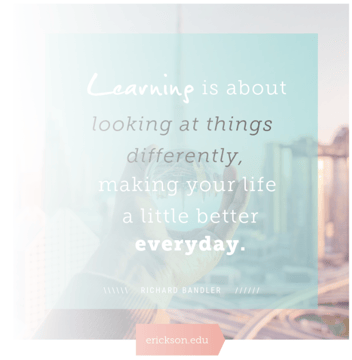And that’s OK!
In a happy, fuzzy world of unicorns and rainbows, learning is a non-stop fun time of opening up your mind to new experiences and ways of thinking. Of course, as actual human beings who have ever been in any kind of school for anything know…learning can be hard. It can make your brain hurt. There are times when you’ll catch yourself saying, “I just don’t get it!” – when really, what you mean to say is, “I just don’t get it yet. But I will.” If learning all subjects was easy and came naturally to everyone – well, we wouldn’t have schools, or teachers, or coaches.
It says something about this common struggle and commitment to learning that if you wind up on a street anywhere, you’re probably not far from some kind of place of learning (and now you don’t even need to physically be on any street, if you want to learn online, of course).
Learning is hard – but you have to remind yourself to focus on the end goal. Watching an old clip of the Letterman show where famed comedian Louis C.K. appears, I was struck by how matter-of-factly he stated what we all need to remember:
My kids panic when they [can’t figure out a problem]. And that’s ok. My mother was a math teacher and she taught me that the moment where you go "I don’t know what this is!"—the moment when you panic—means you’re about to figure it out. That means you let go of what you know and are about to grab onto a new thing that you didn’t know yet. I’m there for them in those moments.
How to Get Past the Discomfort of Learning
We all experience that panic that Louis talks about. When we don’t get past it, we might give up. We shut off the video, put down the book, skip class, or even give up the course altogether as a lost cause. Instead of quitting, here are some ways to push past that discomfort that have worked for our students:
- Take a Break and Come at the Problem Later. This doesn’t mean putting off the lesson forever like a classic procrastinator. Sometimes, you just need to refresh and the solution can appear when you’re not expecting it. At the very least, by leaving the problem and coming back to it after, you may be able to see a way forward that wasn’t clear when you were cramming non-stop.
- Get Help from Your Peers. Peer collaboration is built into our learning processes for a good reason: people tend to learn better together, when they can benefit from other perspectives.
- Review what You Already Know – and How You Got There. Very often, courses are constructed like building blocks. See how you got ‘from point A to point C’ – and the way to get to ‘D’ may become clear. Sometimes, a lesson can seem more difficult than it needs to be because you actually missed a key step before.
- Stay Positive. When you’re having trouble with a particular lesson, remember that nobody put the problem there expressly to trip you up. Your trainer, peers and school want you to succeed. No one is putting up roadblocks for you, so don’t do it to yourself. You will get through this.
- Switch Up Your Learning Method. We don’t all learn the same way – and with self-directed learning, you’ve often got a choice about how you want to take in concepts. Some of us are good visual learners (“Monkey see, monkey do”). Some of us are listeners who need detailed explanations to understand how concepts work. Some students learn best by doing and flourish when they’ve got a practical assignment in front of them. Figure out your optimal learning style from trial and error and use that method to the fullest.



